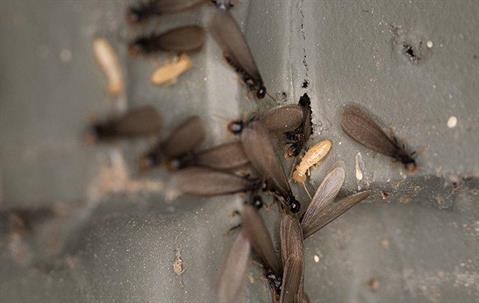You have probably heard of termites, but have you ever seen one, up close and personal? Chances are you have but didn’t know it. Despite typically being underground pests that avoid sunlight at all costs, some termites may be seen buzzing about this time of year. We are talking about termite swarmers. Here are some things you should know about them.
What Are Termites?
Termites are subterranean pests that typically live underground outside and feed on dead and decaying plant matter and trees. Occasionally, however, termites can find food within the wooden walls and foundations of our homes. If your home is currently under siege by termites, here are some things you should know.
Termites do not typically live inside homes but instead nearby underground.
Termite colonies consist of workers, soldiers, and reproductives, each with their own unique and important jobs.
Termite colonies can contain upwards of 15 million individual termites.
If your home is tasty enough, termites might build multiple colonies around its exterior in order to feed upon it.
A fully mature colony of termites can eat a 2x4 in just 6 months.
What Is Swarming Season?
Once a year, subterranean termites do something called swarming. This is an event where fully mature termite colonies spawn reproductive termites (kings and queens) that have wings. These winged termites, also known as swarmers or alates, are given the job of leaving their colony and establishing new ones, usually nearby. As mentioned earlier, if your home is tasty to termites, they might just set up a new colony right next to their old one, then there will be two colonies of termites feeding on your building.
What do termite swarmers look like? A lot like flying white ants actually. What is sad is that many people have seen swarming termites inside their homes and dismissed them, thinking they were just harmless ants. This couldn’t be further from the truth. If you are seeing black insects with white wings around your home, or long wings on window sills, you have a problem.
The good news is that seeing swarmers around your home is the fastest way to know termites are nearby. The bad news is that seeing swarmers inside or outside your home almost definitely means your home is already under attack by a fully mature colony.
Signs Of Ongoing Termite Activity
You think you have found swarmers in your home, but are unsure if termites have infested. Here are some other signs you can look for.
Pencil-sized mud tubes running up your home’s exterior foundation.
Frass (termite droppings) around tiny holes in walls and at their base. Frass looks a lot like fine wood shavings.
Hollow-sounding structural wood.
Overly squeaky floorboards.
Tight-fitting doors and windows.
Soft clicking noises coming from inside your walls.
Buckling walls.
Other strange structural damage related to wood.
It is good to note that the longer termites are allowed to eat away at a home, the more severe the damage becomes. If you are finding serious structural problems around your home, it probably means termites have been around for a while.
How To Protect Your Home Against Termites
A great thing you can do to keep your home safe from termites is to address moisture issues and fix or replace wood that has been water damaged. This can be done partly by fixing leaks, repairing broken gutters, eliminating standing sources of water near your home, and installing dehumidifiers in basements and other humid areas of your home.
The best thing you can do to keep termites away from your Dallas home is to get the experts here at Addison Pest Control involved. We have advanced and reliable methods to ensure termites stay away from your home and your wallet.
Don’t wait to get your home the protection it needs. Give Addison a call today to find your solution to termite problems.

